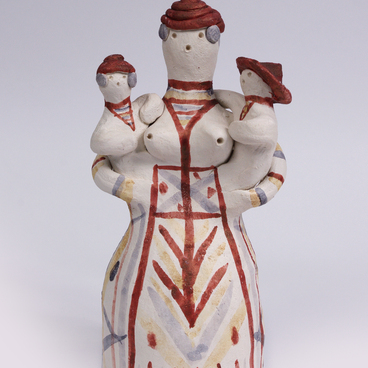The clay horseman was made by the folk craftswomen Oksana Roshchupkina in 2016. She created the figurine following the template of old toys found in the Cossack settlement — they date back to the times of the Oskol fortress. Old potters call such figurines ‘generals’. There are no molded decorations — all the details, including the warrior’s “peaked cap”, were made by stretching one piece of clay. The horse’s and horseman’s eyes and mouth were designed as oblong punctures.
The whistle can produce a simple melody. The holes that are used for whistling are located on the back of the tail. There are also two holes called “frets” on the sides of the animal. Pressing them with fingers helps create different tones.
Oksana Roshchupkina was born in Stary Oskol in 1980. She graduated from Voronezh State Pedagogical University, majoring in teaching crafts, sketching, and decorative and applied art. The artist works in different techniques. She paints icons, wooden products, creates ceramic pictures, makes decorative pottery. Like most ceramic artists from Stary Oskol, she is fond of local clay toys.
The art historian Elena Andrusenko named several characteristics of this craft. The first one is genial naivety. Rams with horns curved into circles, short stumpy horses, slender damsels with their hands on their hips — all these figurines are so cute and adorable. The second characteristic has to do with gentle curved outlines. There are no sharp angles or jagged lines apart from the painted fishbone patterns and dashed lines. The third characteristic is the unpolished surface. Every toy retains the traces of the artisan’s hands. And of course, the significant role of the toy whistle is its pure, deep sound.
Birds and ‘ducklings’ having generalized shapes are considered the first whistles. These are usually separate accidental archeological findings. Surprisingly, even the most antique whistles make a loud and pure sound, and the sound quality does not depend on the period of the toy’s creation. Sometimes even partial damages do not spoil the sound.
The whistle can produce a simple melody. The holes that are used for whistling are located on the back of the tail. There are also two holes called “frets” on the sides of the animal. Pressing them with fingers helps create different tones.
Oksana Roshchupkina was born in Stary Oskol in 1980. She graduated from Voronezh State Pedagogical University, majoring in teaching crafts, sketching, and decorative and applied art. The artist works in different techniques. She paints icons, wooden products, creates ceramic pictures, makes decorative pottery. Like most ceramic artists from Stary Oskol, she is fond of local clay toys.
The art historian Elena Andrusenko named several characteristics of this craft. The first one is genial naivety. Rams with horns curved into circles, short stumpy horses, slender damsels with their hands on their hips — all these figurines are so cute and adorable. The second characteristic has to do with gentle curved outlines. There are no sharp angles or jagged lines apart from the painted fishbone patterns and dashed lines. The third characteristic is the unpolished surface. Every toy retains the traces of the artisan’s hands. And of course, the significant role of the toy whistle is its pure, deep sound.
Birds and ‘ducklings’ having generalized shapes are considered the first whistles. These are usually separate accidental archeological findings. Surprisingly, even the most antique whistles make a loud and pure sound, and the sound quality does not depend on the period of the toy’s creation. Sometimes even partial damages do not spoil the sound.




